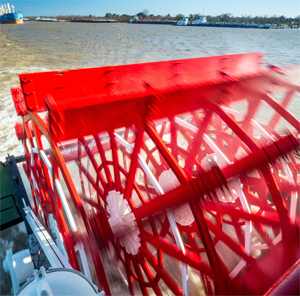From the pilothouse of the steamer Natchez, a sternwheeler based in New Orleans, pilot Troy Delaney was looking straight ahead.
For the first hour of the Mississippi River cruise, he and Capt. Steven Nicoulin were on the lookout for an oversized tree trunk bobbing in the muddy waters. Minutes earlier, a towboat captain said over radio that the “big ol’ log” had just floated past. Delaney grabbed the binoculars and found what he was looking for.
“There’s that tree trunk right there,” he said, handing off the binoculars.
“You see that brown speck? That’s damn near a tree trunk down there,” he said, pointing to a dark outline near the Chalmette Ferry crossing.
The Mississippi River was receding, but weeks of high water had carried trees, logs and other debris from the banks. Trees and large drift are bad enough for a screw propeller, but potentially worse for Natchez’s 25-foot wood and steel paddle wheel.
“Most likely that wheel would probably chew it up,” Nicoulin said of the 26-ton wheel. “But there is a possibility it could wedge between your rudders and jam your rudders up.”
“The worst ones are the ones you can’t see,” he added.
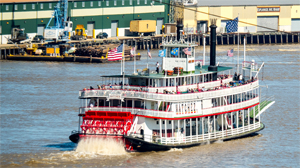 |
|
Natchez pushing down the Mississippi River in New Orleans during a sunny late-winter cruise. The vessel is the ninth steamer to bear the name Natchez. Its predecessor, Natchez VI, raced Robert E. Lee in the most famous steamboat race of all time. |
This log, however, was safely downriver. Natchez was seven miles from the French Quarter and preparing to turn around.
The 265-foot Natchez was in the midst of an afternoon voyage in mid-February under sunny skies, 70-degree temperatures and light winds. Vessel traffic along this notoriously busy section of river was lighter than usual, with several towboats, fleet boats and articulated tug-barges on the water but few large tankers and containerships. In other words, it was a perfect day for a cruise.
Natchez was constructed in 1975 and has been a fixture in New Orleans for 40 years. The 1,200-passenger vessel was built in homage to eight predecessors with the same name that plied the Lower Mississippi for most of the 19th century. Historic elements on this model include its design, functioning calliope steam organ and a bell cast from 250 silver dollars.
Natchez makes three two-hour cruises a day from the Toulouse Street Wharf, just a short walk from iconic Jackson Square. The vessel has three levels, starting with the main deck housing the engine room, boilers, generators and galley. Upstairs is the main salon dining room and hurricane deck outdoor seating area on the stern. The gift shop is located on the Texas Deck.
New Orleans Steamboat Co. owns Natchez, and the company boasts of the vessel’s speed, noting its namesake has never lost a steamboat race. These days, Natchez is one of two steam-powered sternwheelers left on the river. While many upriver ports offer paddle-wheel river cruises, most are diesel powered — including Creole Queen, also based in New Orleans.
The pilothouse sits atop the Texas Deck. After rounding the bend at Algiers Point, perched in his pilot’s chair, Delaney had Natchez set for full-ahead while Nicoulin stood by. The vessel was making about 14 knots with the help of a 4.5-mph current. The river measured 11.7 feet, well below the 17-foot flood stage but still considered high water.
The river between New Orleans and Chalmette is lined with wharves, fleeting areas and tugboat companies, so vessels are constantly coming and going. There is heavy barge and ship traffic traveling to oil terminals, the Port of New Orleans and other facilities. Just downriver of Algiers Point, Natchez approached a small pushboat moving barges from fleeting areas across the river. Delaney made starboard-to-starboard passing arrangements over the radio.
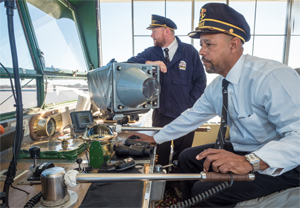 |
|
Pilot Troy Delaney on the bridge of Natchez with Capt. Steven Nicoulin looking downriver. |
“Yeah, Cap, coming down on Alabo, slip past you on two whistles?” Delaney said, referring to the Alabo Street Wharf. The tow captain agreed, slowing to let Natchez pass.
The steamboat has been a steady presence on the river for nearly 40 years, and most local captains are used to seeing it at the same times each day, Nicoulin said. More often than not, they’ll let Natchez through.
“The good thing about working the area we work … you get to know the fleet boats and a lot of the fleet boats get to know you really well,” he said, adding that captains realize that the excursion boat has a schedule to keep.
Down below, roughly 500 guests ate from the Southern buffet and sipped cocktails as the narrator pointed out various landmarks, including the Industrial Canal, the Lower Ninth Ward still rebuilding from Hurricane Katrina, and the Domino Sugar refinery.
About an hour into the cruise, when the riverboat reached the massive Chalmette oil refinery, Delaney made preparations to turn around. With plenty of room to maneuver, he set the power to half-ahead and then to dead-stop, allowing the vessel to gradually slow down. Then, he requested half-astern to begin swinging her around.
“Steamer Natchez, stopping and topping at Chalmette refinery, we’ll be backing in toward the east bank, steamer Natchez,” Delaney announced over radio.
Unlike conventional vessels, there is no engine throttle in the Natchez pilothouse. Using a brass knob, the pilot chooses the appropriate engine command on the telegraph, setting off a bell in the pilothouse and the engine room. The bell goes silent when the engineer down below matches the command in the engine room.
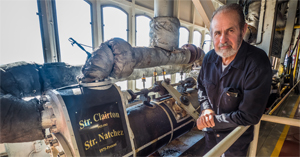 |
|
Scott Vieages, port and chief engineer on the steamboat Natchez. The steam engines driving the vessel are from the U.S. Steel Corp. sternwheel towboat Clairton built in 1925. |
“He tells me what he wants to go, whether he wants to go fast, slow, dead-slow, full-ahead, reverse,” said longtime Natchez engineer Scott Vieages, who initially worked for the shipyard that built the steamer before coming on board full time. “It’s got double needles in the indicator, so when he turns one, it indicates what he wants and you have to match it.”
Natchez is powered by two 800-hp steam engines built in 1925 for the towboat Clairton, which moved steel on the Monongahela River. The boilers burn diesel fuel to power the engine, although Vieages said typically one boiler runs at a time. Each engine is equivalent to about 1,600 to 2,000 hp in a conventional vessel.
Natchez has three 17-by-5-foot rudders in front of the 26-ton sternwheel. It does most of its maneuvering when backing up as water from the wheel rushes through the rudders. The vessel has a 200-hp bow thruster primarily used for docking.
Using the wind, current and rudders, Natchez slowly spun around. When it was just where Delaney wanted it, he signaled the telegraph full-ahead and the engines rumbled to life, pushing upriver against the current. He aimed the vessel toward the west bank and set a course toward the French Quarter.
“There is a little trick to turning them around. Since the weight is on the back end, you always want to do everything with the wind,” Nicoulin said. “You always want to back into the wind because when you back into the wind, the wind is taking the head because it’s light. She’ll stop right on a dime.”
With favorable offshore winds, Natchez pushed upriver, hugging the bank. Delaney described this area within 150 feet from land as “easy water” due to its milder current. The vessel’s depth finder measured 70 and 80 feet, plenty of room for the steamer’s 6.5-foot draft. Against the current, Natchez was making about 7 mph.
Soon the vessel approached General Anchorage where four ships sat waiting their turn at berth. Delaney announced the steamer’s presence and steered between the ships on the starboard side and the barge fleeting areas to port. All the while, he kept an eye on pushboats preparing to leave the fleeting areas.
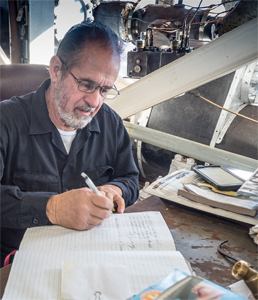 |
|
Vieages entering in the log. |
Delaney made another call over the radio as the vessel entered the anchorage. Moments later, he addressed the captain of towboat Niles Shoemaker.
“Yeah, Cap, coming up astern on you, slip by you on one? I see your prop wash there,” Delaney said.
“Yes sir, I’m going to hold it right here,” Shoemaker’s captain answered.
Steering between the fleeting areas and ships gives the passengers a chance to see different vessels up close. Passing the third ship in the anchorage, Delaney steered toward the east bank, approaching the fourth and final ship from the port side. The course change gave passengers on that side a better view, he said.
Natchez has a basic suite of navigational equipment, including two radar displays — one of which dates to 1982 — a digital chart reader with AIS and ship-to-shore and ship-to-ship radio. Crew use the displays to monitor the speed and heading of approaching vessels, particularly around Algiers Point. High water reduced traffic to one way around the bend, and Delaney and Nicoulin were checking for downriver traffic. If they’re set to meet a downbound vessel at the point, the steamer typically will slow down to let it through, Nicoulin said.
Passing more fleeting areas and the sprawling government complexes in the Federal City section of Algiers, Delaney contacted Vessel Traffic Services to arrange passage around the point. After receiving the all-clear, he made arrangements to pass the downbound pushboat Red River Express on two whistles.
Creole Queen, the other New Orleans-based paddle wheeler, made a similar call to Red River Express a few seconds later.
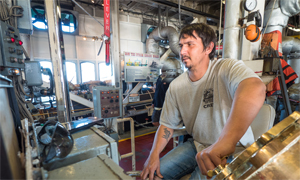 |
|
Robert Jones, the oiler on the steamboat Natchez, monitors and controls the steam pressure and vessel direction, forward or aft, in response to the bell from the bridge. |
“Welcome, Captain Chico!” Delaney exclaimed after hearing his counterpart, Capt. Donald “Chico” Rojas, on the radio.
“Even though they’re our competitor, we’ve got a working relationship,” Delaney explained.
Nearer to Algiers Point, the vessel passed Crescent Towing’s floating facility and homes visible beyond the levee in the city’s Algiers neighborhood. Delaney continued to hug the west bank, where another area of slack water waited on the downstream side of the point. Against the subdued current, Natchez’s speed quickly jumped from about 7 mph to 11 mph. Those gains were short-lived however, as the speed crept back to around 7 mph north of the point.
“The current comes down here and hits this bend and it just wraps around,” Nicoulin said, gesturing out beyond the point into the middle of the river, explaining the rapid increase in speed.
As Delaney navigated around the bend, Nicoulin pointed out “boils” in the river caused by the converging currents during high water. These spots, identified by smooth, churning water resembling hot water on the stove, can affect steering at slower speeds.
“This turn right here and the turn at Vicksburg, these are the most brutal turns on the river,” Nicoulin said. “If you don’t know what you’re doing, it can make for a bad day.”
Clear of the bend, Delaney made a radio call to the Algiers Ferry, a pedestrian boat that runs straight across the river between Canal Street and Algiers Point. The ferry was loaded and ready to go.
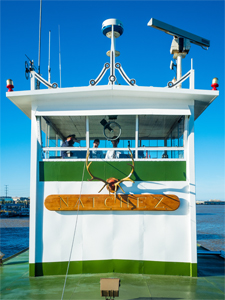 |
|
Natchez won the antlers years ago in a steamboat race and has kept them ever since. Even today, Natchez is proudly the undisputed champion of the Mississippi, never having been beaten in a race. |
“Yeah, Captain Ray, coming up astern of you. Take you on one, Cap,” Delaney said.
“Yeah, come on skipper,” the ferry captain responded, “I got my good eye on you.”
Natchez reduced speed to half-ahead as the vessel passed the terminal. It steamed past the Bollinger ship repair facility on the west bank and another large barge-fleeting area. Delaney gave the ferry plenty of space and steered across the river toward the New Orleans Riverwalk and shopping complex.
After returning to the east bank, Natchez approached the Crescent City Connection bridge where dredge crews were working under the easternmost span. Delaney used another helpful wind and the current to spin the vessel around so it was again facing downriver. He lined up his approach with the wharf about a quarter-mile ahead.
“We got an onshore wind, and we got an upstream eddy, so we pretty much have two things in our favor,” Delaney said. “The only thing is, with an onshore wind I just have to stay out wide for the dock and basically let the wind and the current do the docking for me.”
Closer to the wharf, Nicoulin walked to a bridge at the bow of the steamboat to guide Natchez into its landing. Using a megaphone, he watched the steamer as it approached the wharf, calling out engine, rudder and thruster commands for Delaney to execute. Although he’s 100 feet from the pilothouse, Nicoulin was fully in control of the boat.
With engines at idle and the vessel aligned parallel to the dock, Nicoulin called out “Back half!”
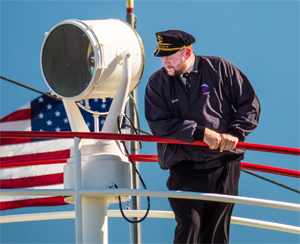 |
|
Capt. Steven Nicoulin lets go the lines while setting out on a Mississippi River cruise from New Orleans. |
“We’re backing half midship,” Delaney confirmed over the microphone.
Nicoulin then called out commands for rudders to stern, then back to midship while winds slowly pushed the boat toward the wharf.
After a few more commands, Nicoulin called for the paddle wheel to stop and rudders back to midship. He then asked for power ahead with rudders at midship.
About 30 seconds later, after the stern and bow lines were set, Nicoulin ordered a full stop as the vessel lined up against the wharf with barely a nudge. It was a near-perfect landing after a smooth two-hour cruise.
There was little time for the crew to admire their work. Another cruise was due to begin shortly.

